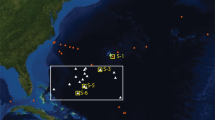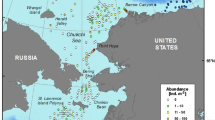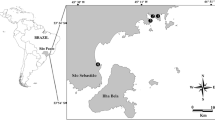Abstract
Pelagic Sargassum was collected in late summer, late winter, and early and late spring from inshore waters, the Gulf Stream and the Sargasso Sea of the Western North Atlantic Ocean. The noncolonial macrofauna was picked from the weed samples. The 34 samples contained 67 species and 11,234 individuals. The Shannon-Wiener index of diversity had a mean value of 2.419±0.177 (t.05s −x ) and a statistical range between 1.401 and 3.437 (t.05 s). Mean diversity values were not significantly different among the various sampling series, and diversity did not vary with raft volume. High diversity values were related to an equitable distribution of species resulting from a stable environment and an area low in productivity. Species composition of the Sargassum organisms varied seasonally and geographically. Animals were more abundant in the spring than in the fall samples. Samples collected on a transect in the Gulf Stream and Sargasso Sea maintained a similar faunal composition.
Similar content being viewed by others
Literature cited
Adams, J. A.: A contribution to the biology and postlarval development of the Sargassum fish, Histrio histrio (Linnarus), with a discussion of the Sargassum complex. Bull. mar. Sci. Gulf Caribb. 10, 55–82 (1960).
Berry, F. H. and L. E. Vogele: Filefishes (Monocanthidae) of the Western North Atlantic. Fishery Bull. U.S. Fish Wildl. Serv. U.S. 61, 61–109 (1961).
Conover, J. T. and J. McN. Sieburth: Effect of Sargassum distribution on its epibiota and antibacterial activity. Botanica mar. 6, 147–157 (1964).
Deacon, G. E.: The Sargasso Sea. Geogrl. J. 99, 16–28 (1942).
Fager, E. W.: Communities of organisms. In: The sea, Vol. 2, pp 415–437. Ed. by M. N. Hill. New York: Interscience 1963.
Gooding, R. M. and J. J. Magnuson: Ecological significance of a drifting object to pelagic fishes. Pacif. Sci. 21, 486–497 (1967).
Grassle, J. F.: Influence of environmental variation on species diversity in benthic communities of the continental shelf and slope. Unpubl. Ph.D. Dissert., Duke Univ., Durham, North Carolina 1967.
Harrison, W., J. J. Norcross, N. A. Pore and E. M. Stanley: Circulation of shelf waters off the Chesapeake Bight. Surface and bottom drift of continental shelf waters between Cape Henlopen, Delaware, and Cape Hatteras, North Carolina, June 1963 to December 1964. Prof. Pap. environ. Sci. Serv. Adm. 3, 1–82 (1967).
Hedgpeth, J.: The Pycnogonida of the Western North Atlantic and the Caribbean. Proc. U.S. natn. Mus. 97, 157–342 (1948).
Hentschel, E.: Über den Bewuchs auf den treibenden Tangen der Sargassosee. Mitt. zool. Mus. Hamb. 38, 1–26 (1922).
Ida, H., Y. Hiyama and T. Kusaka: Study on fishes gathering around floating seaweed. II. Behavior and feeding habit. Bull. Jap. Soc. scient. Fish. 33, 930–936 (1967).
Jones, G. F.: The benthic macrofauna of the mainland shelf of Southern California. Allan Hancock Monogr. mar. Biol. 4, 1–219 (1969).
Krümmel, O.: Die nordatlantische Sargassosee. Petermanns geogr. Mitt. 37, 129–141 (1891).
Lloyd, M. and R. J. Ghelardi: A table for calculating the equitability component of species diversity. J. Anim. Ecol. 33, 217–225 (1964).
— J. H. Zar and J. R. Karr: On the calculation of information-theorerical measures of diversity. Am. Midl. Nat. 79, 257–272 (1968).
MacArthur, R. H.: On the relative abundance of bird species. Proc. natn. Acad. Sci. U.S.A. 43, 293–295 (1957).
Margalef, R.: Some concepts relative to the organization of plankton. Oceanogr. mar. Biol. A. Rev. 5, 257–289 (1967).
— Perspectives in ecological theory, 111 pp. Chicago: University of Chicago Press 1968.
Markkaveeva, E. G.: The biocenosis of sargasso algae in the Red Sea. [Russ.] In: Bentos, pp 81–93. Kiev: Dumka Nauk 1965.
Mills, E. L.: The community concept in marine zoology, with comments on continua and instability in some marine communities: a review. J. Fish. Res. Bd Can. 26, 1415–1428 (1969).
Murray, J. and J. Hjort: The depths of the ocean, 821 pp. London: MacMillan and Co., Ltd. 1912.
Parr, A. E.: Quantitative observations on the pelagic Sargassum vegetation of the Western North Atlantic. Bull. Bingham oceanogr. Coll. 6, 1–94 (1939).
Pianka, E. R.: Latitudinal gradients in species diversity: a review of concepts. Am. Nat. 100, 33–46 (1966).
Pilsbry, H. A.: The barnacles (Cirripedia) contained in the collections of the U.S. National Museum. Bull. U.S. natn. Mus. 60, 1–122 (1907).
Prat, H.: Remarques sur la faune et la flore associes aux Sargasses flottantes. Naturaliste Can. 62, 120–129 (1935).
Sanders, H. L.: Benthic studies in Buzzards Bay. III. The structure of the soft-bottom community. Limnol. Oceanogr. 5, 138–153 (1960).
— Marine benthic diversity: a comparative study. Am. Nat. 102, 243–282 (1968).
Shannon, C. E.: A mathematical theory of communication. Bell Syst. tech. J. 27, 379–423, 623–656 (1948).
Sieburth, J. McN. and J. T. Conover: Sargassum tannin, an antibiotic which retards fouling. Nature, Lond. 208, 52–53 (1965).
Thomson, C. W.: The voyage of the Challenger, the Atlantic, Vol. 2, 340 pp. New York: Harper and Bros 1878.
Thulin, G.: Ein neuer mariner Tardigrad. Göteborgs K. Vetensk.-o. VitterhSamh. Handl. 2 (5), 1–10 (1942).
Timmermann, G.: Biogeographische Untersuchungen über die Lebensgemeinschaft des treibenden Golfkrautes. Z. Morph. Ökol. Tiere 25, 288–335 (1932).
Weis, J. S.: Fauna associated with pelagic Sargassum in the Gulf Stream. Am. Midl. Nat. 80, 554–558 (1968).
Williams, A. B.: Marine decapod crustaceans of the Carolinas. Fishery Bull. U.S. Fish Wildl. Serv. U.S. 65, 1–295 (1965).
Winge, Ö.: The Sargasso Sea, its boundaries and vegetation. Rep. Danish oceanogr. Exped. Mediterr. 3 (Misc. Pap. No. 2), 1–34 (1923).
Woodcock, A. H.: Subsurface pelagic Sargassum. J. mar. Res. 9, 77–92 (1950).
Yeatman, H. C.: The problem of dispersal of marine littoral copepods in the Atlantic Ocean, including some redescriptions of species. Crustaceana 4, 253–272 (1962).
Author information
Authors and Affiliations
Additional information
Communicated by G. L. Voss, Miami
Contribution No. 351 from the Virginia Institute of Marine Science, Gloucester Point, Virginia, USA.
From a thesis submitted to the faculty of the School of Marine Science, The College of William and Mary, in partial fulfillment of the requirements for the degree of Master of Arts in Marine Science.
Rights and permissions
About this article
Cite this article
Fine, M.L. Faunal variation on pelagic Sargassum . Marine Biology 7, 112–122 (1970). https://doi.org/10.1007/BF00354914
Accepted:
Issue Date:
DOI: https://doi.org/10.1007/BF00354914




